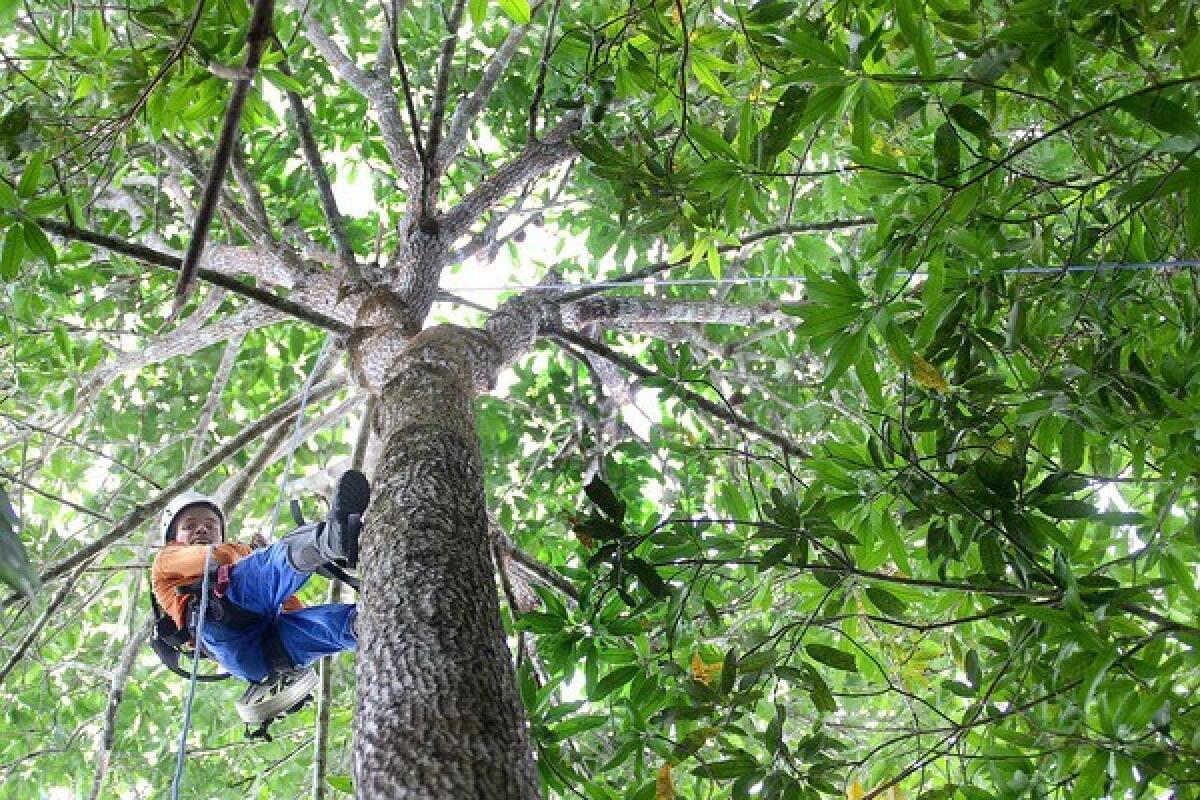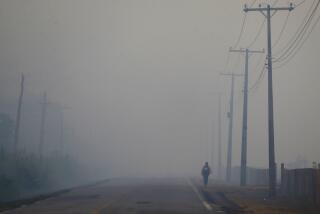Saving the Amazon may be the most cost-effective way to cut greenhouse gas emissions

An hour outside Manaus, the Amazon’s biggest city, the blackened remains of a virgin forest smolder. Chain saws whine. And Jonas Mendes tosses logs, one after another, into his kiln.
“I know it’s wrong to cut down the trees,” said Mendes, 48, sweat streaming down his neck and torso. “But I have no other way to make a living.”
Under a lean-to, his teenage son hacks charcoal into pieces with a machete. His wife fills 110-pound plastic bags that sell for $4 each.
If the Obama administration succeeds in its pledge to curb climate change, billions could flow from the U.S. to help forest dwellers such as Mendes change their ways.
Governors of the Brazilian Amazon’s nine states are pushing the U.S. and other industrial nations to invest in projects under rules known as REDD -- or Reducing Emissions from Deforestation and Degradation -- that are being designed through the auspices of the United Nations.
Under pending legislation to cap greenhouse gases, the U.S. government would auction emission allowances, funneling as much as $3 billion from the annual proceeds into rain forest protection. U.S. companies facing carbon controls could meet part of their obligations by investing as much as $13 billion a year by 2020 to preserve forests.
And several Amazon governors have signed agreements with California Gov. Arnold Schwarzenegger to measure the carbon in their forests with the goal of selling carbon credits in California’s cap-and-trade market, set to begin in 2012. The program would allow California businesses to use the credits to meet their emission caps, and thus funnel several hundred million dollars a year into tropical forest protection.
The reason? Slash-and-burn deforestation accounts for about 15% of humanity’s carbon dioxide emissions. Despite activists’ efforts, forests have been disappearing at the rate of about 34 million acres a year for the last two decades. Globally, Indonesia and Brazil are the third- and fourth-largest emitters respectively of greenhouse gases, after China and the U.S., because of their breakneck pace of forest destruction.
Saving the Amazon, Earth’s largest tropical jungle, can be a cheaper and faster way to avoid greenhouse gas emissions than replacing coal-fired power plants with renewable energy or switching to electric cars -- although all such measures are considered necessary by climate experts.
President Obama acknowledged as much last fall.
“It is probably the most cost-effective way for us to address the issue of climate change, having . . . mechanisms in place to avoid further deforestation,” he said.
Despite the failure to adopt a long-term climate treaty in Copenhagen last year, the U.S., along with Australia, Britain, France, Japan and Norway, promised $3.5 billion in fast-start funds to help preserve tropical forests.
Forest livelihood
But if nations across Latin America, Africa and Asia are to guard their trees, they must first alleviate the poverty of 1.2 billion people who depend on forests for their livelihoods. Many of these developing nations, struggling economically, bristle at preaching from wealthier countries.
“Let no gringo ask an Amazonian to die of hunger under a tree,” Brazilian President Luiz Inacio Lula da Silva warned recently.
“We want to preserve,” he added. “But they should pay.”
Beginning in the 1960s, politicians in Brazil pushed to populate the rain forest and to clear tracts for cattle, soybeans and timber. Across the Amazon, homesteaders were promised title to their plots if they cut down trees to make the land “productive.”
But the policy known as Land Without People for People Without Land has backfired. Rain forest soil is unsuited to small-scale agriculture. Malaria is rampant. Jaguars devour livestock. Many settlers never got title because of bureaucratic snafus and thus have little incentive to protect the forest. Many, like Mendes, survive mainly by felling their trees for charcoal.
Taruma Mirim, where he ekes out a living, is one of 2,500 Amazon settlements created by Brazil’s Institute for Colonization and Agrarian Reform. Behind the tin-roofed shack where Mendes lives with his wife and four children, he drags logs to his kilns with the help of a half-starved cow.
Mendes has an infected eye, aggravated by fumes.
“The doctor told me I should keep away from smoke, but I have no choice,” he said.
Wooden huts without running water line the road. Mangy dogs and chickens roam among jaca and cupuacu, local fruit trees.
Since 1991, the family has cut down a third of the trees on its 60-acre plot in the state of Amazonas. Some neighbors have razed their land entirely, only to abandon it and move on to repeat the cycle of destruction.
“It was a bad model,” said Mariano Cenamo, head of the nonprofit Institute for Conservation and Sustainable Development of Amazonas. “After a few years of trying to survive, settlers start selling off.”
Cattle ranchers, spreading herds thinly on depleted land, or big soybean growers who can afford chemical fertilizers then move in.
‘Arc of fire’
Today, the Amazon basin, which also covers parts of eight other nations, harbors 45% of Earth’s remaining rain forest. In the last 35 years, about 17% of it has been razed. In Brazil, the “arc of fire,” as it is known, is more than twice the size of California.
But consciousness of the Amazon’s worth as a standing forest, rather than as a cut forest, is mounting. The Amazon stores between 80 billion and 130 billion metric tons of carbon in its leaves and trunks, which, if burned, would emit about 50 times more carbon dioxide than the United States’ annual output.
As a result, Brazil is beginning to enact tough measures. It has beefed up its space agency, which now tracks destruction by satellite in real time so police can be speedily dispatched to halt illegal logging. In the last four years, the government has created 193,000 square miles of forest reserves. The land reform agency has stopped building settlements in virgin forest, and today, by law, only 20% of an individual’s land may be deforested.
“We are working hard on the topic of climate change,” said Environment Minister Carlos Minc, noting that the government recently signed pacts with the soybean, timber and mining industries to prevent sales from newly deforested areas. Loans to illegal land grabbers are being blocked.
New figures show that since 2004, the extent of burning in the Brazilian Amazon has dropped to 2,705 square miles a year from a peak of 10,588 square miles annually.
But how much of the drop is due to government policy and how much to fluctuating prices of beef and soy, the main drivers of deforestation, is unclear. Even at today’s levels, more forest land is razed in Brazil than anywhere in the world except Indonesia.
Brazil is the world’s largest soybean exporter and the second-largest meat exporter, after Australia -- and it wants to stay on top. Vast new acreage is expected to be cleared for sugar cane to expand Brazil’s effort to replace gasoline with biofuel.
The government boasts that it has doubled the number of rangers to 1,400, targeting areas such as the state of Para, where confrontations have turned violent. But in Taruma Mirim, settlers dismiss the fiscais, as they call government inspectors, with scorn.
“They see us stoking the kiln,” said Gilmar Santana, 29, pausing by the road with a chain saw on his shoulder. “They say don’t do that, but we say we must. Then they go away.”
Today, many of the reserves that cover 43% of the Brazilian Amazon remain paper-only decrees. Government agents issued $1.6.billion in fines for illegal logging last year, but collected less than 1% of the money.
A recent Greenpeace report, “Slaughtering the Amazon,” traced beef and leather from illegally deforested land as it surreptitiously made its way into global supply chains of such firms as Nike, IKEA, Kraft Foods and Wal-Mart.
In response, the government promised to implement a program to track cattle with electronic tags and seize “illegally raised” animals.
Center of conflict
From his office in a modern building in Manaus, Denis Minev, secretary of planning and development for Amazonas, sits at the center of the conflict.
“I’m considered the devil,” he said with a wry smile. He considers conservation a priority but also favors controversial highways through parts of the forest.
At 32, he is one of Brazil’s hip young technocrats, with an undergraduate degree from Stanford University, an MBA from the University of Pennsylvania’s Wharton School and a stint at investment bank Goldman Sachs Group Inc. under his belt.
Minev and other Amazonas officials have successfully enforced price supports for such forest products as Brazil nuts and rubber, incentives to keep trees standing. A national effort to clear up titles to land will also make it easier for farmers and ranchers to get loans to boost productivity of existing plots, thereby lessening the need to raze virgin forest.
“Previously the forest was seen as a barrier to development,” Minev said. “But there has been a major shift in vision.”
Minev has squired U.S. legislators such as Rep. Edward J. Markey (D-Mass), coauthor of the House climate bill, around the jungle in hopes that Congress will adopt a cap-and-trade program. Funds from the U.S. could then be used to police conservation areas, improve land fertility to reduce demand for deforestation and help forest dwellers find better ways to make a living than by making charcoal.
In Taruma Mirim, settlers have heard that help could be on the way.
“We want to preserve the forest,” said Mendes, pausing from his sweaty work. “If the money from abroad reaches us, it could change the situation.”
The walls of his home are bare except for a clock with a painted scene of Noah’s Ark.
margot.roosevelt@
latimes.com
More to Read
Inside the business of entertainment
The Wide Shot brings you news, analysis and insights on everything from streaming wars to production — and what it all means for the future.
You may occasionally receive promotional content from the Los Angeles Times.











